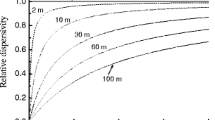Abstract
The laboratory-scale ground water transport equation with nonequilibrium sorption reaction subjected to unsteady, nondivergence-free, and nonstationary velocity fields is up-scaled to the field-scale by using the ensemble-averaged equations obtained from the cumulant expansion ensemble-averaging method. It is found that existing ensemble-averaged equations obtained with the help of the cumulant expansion method for the system of linear partial differential equations are not second-order exact. Although the cumulant expansion methodology is designed for noncommuting operators, it is found that there are still commudativity requirements that need to be satisfied by the functions and constants exist in the coefficient matrix of the system of ordinary/partial differential equations. A reversibility requirement, which covers the commudativity requirements, is also proposed when applying the cumulant expansion method to a system of partial differential equations/a partial differential equation. The significance of the new velocity correction obtained in this study due to the applied second-order exact cumulant expansion is investigated on a numerical example with a linear trend in the distribution coefficient. It is found that the effect of the new velocity correction can be significant enough to affect the maximum concentration values and the plume center of mass in the case of a trending distribution coefficient in a physically heterogeneous environment.













Similar content being viewed by others
References
Cvetkovic VD, Shapiro AM (1990) Mass arrival of sorptive solute in heterogeneous porous media. Water Resour Res 26(9):2057–2067
Dagan G (1982) Stochastic modeling of groundwater flow by unconditional and conditional probabilities 2. The solute transport. Water Resour Res 18(4):835–848
Dagan G (1984) Solute transport in heterogeneous porous formations. J Fluid Mech 145:151–177
Dagan G (1987) Theory of solute transport by groundwater. Ann Rev Fluid Mech 19:183–215
Dagan G, Neuman SP (1991) Nonasymptotic behavior of a common Eulerian approximation for transport in random velocity fields. Water Resour Res 27(12):3249–3256
Dentz M, Berkowitz B (2005) Exact effective transport dynamics in a one-dimensional random environment. Phys Rev 72:031110
Espinoza C, Valocchi AJ (1997) Stochastic analysis of one dimensional transport of kinetically adsorbing solutes in chemically heterogeneous aquifers. Water Resour Res 33(11):2429–2445
Gelhar LW, Axness CL (1983) Three-dimensional stochastic analysis of macrodispersion in aquifers. Water Resour Res 19(1):161–180
Grobner W, Knapp H (1967) Contribution to the method of lie series, Bibliographisches Intstitute, Mannheim, Germany
Hu BX, Cushman H (1997) Comparison of nonlocal Eulerian to Lagrangian moments for transport in an anisotropic heterogeneous aquifer with deterministic linear nonequilibrium sorption. Water Resour Res 33(4):891–896
Hu BX, Deng F, Cushman JH (1995) Nonlocal reactive transport with physical and chemical heterogeneity: linear nonequilibrium sorption with random K d . Water Resour Res 31(9):2239–2252
Kabala ZJ, Sposito G (1991) A stochastic model of reactive solute transport with time-varying velocity in a heterogeneous aquifer. Water Resour Res 27(3):341–350
Karakas A, Kavvas ML (2000) Conservation equations for ground-water velocity in general conditions. J Hydrol Eng 5(2):206–216
Kavvas ML (2001) General conservation equation for solute transport in heterogeneous porous media. J Hydrol Eng 6(4):341–350
Kavvas ML, Karakas A (1996) On the stochastic theory of solute transport by unsteady and steady groundwater flow in heterogeneous aquifers. J Hydrol 179:321–351
Morales-Casique E, Neuman S P, Guadagnini A (2006) Non-local and local analyses of non-reactive solute transport in bounded randomly heterogeneous porous media: theoretical framework, Adv Water Resour 29:1238–1255
Quinodoz HA, Valocchi A (1993) Stochastic analysis of the transport of kinetically sorbing solutes in aquifers with randomly heterogeneous hydraulic conductivity. Water Resour Res 29(9):3227–3240
Selroos J, Cvetkovic V (1994) Mass flux statistics of kinetically sorbing solute in heterogeneous aquifers: analytical solution and comparison with simulations. Water Resour Res 30(1):63–69
Sirin H (2006) Ground water contaminant transport by nondivergence-free unsteady, and nonstationary velocity fields. J Hydrol 330:564–572
Sposito G, Barry DA (1987) On the dagan model of solute transport in groundwater: foundational aspects. Water Resour Res 23(10):1867–1875
Suciu N, Vamos C, Eberhard J (2006) Evaluation of the first-order approximations for transport in heterogeneous media. Water Resour Res 42:W11504
Van Kampen NG(1981) Stochastic processes in physics and chemistry. North-Holland, Amsterdam, 419 pp
Wood BD, Kavvas ML (1999a) Ensemble-averaged equations for reactive transport in porous media under unsteady flow conditions. Water Resour Res 35(7):2053–2068
Wood BD, Kavvas ML (1999b) Stochastic solute transport under unsteady flow conditions: comparison of theory, Monte Carlo, and field data. Water Resour Res 35(7):2069–2084
Zavala-Sanchez V, Dentz M, Sanchez-Vila X (2007) Effective dispersion in a chemically heterogeneous medium under temporally fluctuating flow conditions. Adv Water Resour 30:1342–1354
Author information
Authors and Affiliations
Corresponding author
Additional information
An erratum to this article is available at http://dx.doi.org/10.1007/s00477-008-0293-8.
Appendices
Appendix 1
Following van Kampen (1981) the terms inside the ordering symbol may be considered as if they commute time wise so the Eq. 17 can be written as
If \({\int\nolimits_0^t{d \tau A_{0} (\tau)}}\) and \({\int\nolimits_0^t{d \tau \alpha A_{1} (\tau)}}\) commute Eq. 36 becomes
which is
Eq. 38 is also equal to
Since the time ordered and regular exponentials of a constant matrix is the same Eq. 39 is automatically satisfied by A 0(τ) and α A 1(τ) matrices made up of constants. When A 0(τ) and α A 1(τ) contain time dependent functions at least one of those matrices should be a diagonal matrix in order to have the Eq. 39 satisfied since the time ordered exponential and regular exponential of a diagonal matrix with time dependent functions is the same.
Appendix 2
By using Eqs. 25 and 29 together with the separation given in Eqs. 23 and 24 the right hand side of Eq. 16 can be written as
in which
Applying functions and operators in Eq. 40 one obtains
in which
Separating \((\frac{{\partial \langle v_{x} (x + \varsigma ^{*}, \tau) \rangle}}{{\partial x}} + k_{r} K_{d} (x + \varsigma ^{*}, \tau) + k_{r}) {\hbox{I}} \) from \(\alpha A^{+}_{1} (x + \varsigma ^{*}, \tau)\) with the help of Eq. 29, one obtains
in which
Since the second and the third exponentials cancel each other, we are left only with the first and the fourth exponentials in Eq. 42. If the equivalence of the fourth exponential according to Eq. 29 is used in Eq. 42, one can write
Eq. 43 is equal to
which is the left hand side of Eq. 16.
Rights and permissions
About this article
Cite this article
Sirin, H., Mariño, M.A. On the cumulant expansion up scaling of ground water contaminant transport equation with nonequilibrium sorption. Stoch Environ Res Risk Assess 22, 551–565 (2008). https://doi.org/10.1007/s00477-007-0174-6
Published:
Issue Date:
DOI: https://doi.org/10.1007/s00477-007-0174-6




